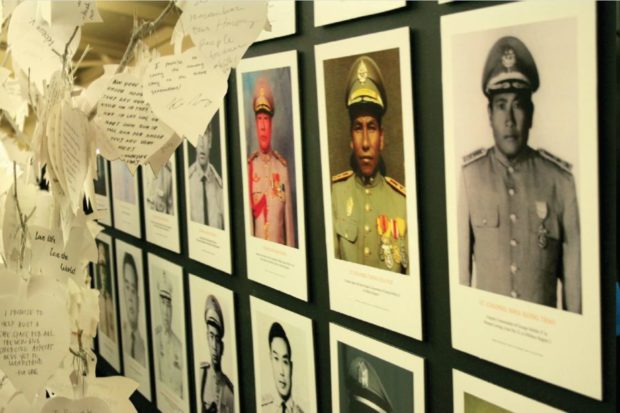
By Vic Bedoian for Pacifica Radio, KFCF Fresno
Forty years after immigrating to the United States from Southeast Asia, the Hmong community in Fresno celebrated with the opening of a major multi-media exhibition documenting their history, and an academic triumph that will help preserve their culture. California State University, Fresno announced this week the creation of a Hmong minor in the Linguistics Department. It’s being hailed as an important step in the study and furtherance of Hmong language and culture. Hmong people, an ethnic minority living primarily in northern Laos, aided the US military and CIA in the Secret War waged against the Communist government. After the war, they were forced to flee to refugee camps set up in Thailand, where they lived until they could be repatriated to a host country. Many thousands landed in the Central Valley where they created a new life.
Hmong people and culture are an enduring part of life in the Central Valley. Hmongstory 40, the exhibit on display at the Fresno Fairgrounds coinciding with the Hmong New Year festivities there, celebrates the bittersweet history of the Hmong in Laos, Vietnam, Thailand, and America. It connects a new generation of Hmong Americans to those experiences, teaches the general public about Hmong history and culture, and documents as much as possible for the future. The visitor is taken through four rooms each filled with text, photos, video, paintings, sculpture and wide variety of artifacts. Lar Yang is a graphic designer who helped make this a reality. He says it was a prodigious effort and labor of love by the many Hmong across the state who donated money and time.
“The first thing we see here… this is the life in Laos. So this is to teach what was happening before the war. You know, what life was like, what culture was like, anything related to culture is in this room. We have leaders from the past. A lot of young kids don’t know we had generations of leaders before, you know before the war, and we have that as well. A lot of the information dates back to China. All this information, anything happening before the civil war is in this room.”
Another room details the secret war in Laos, the trauma that followed, and how Hmong life was changed forever.
Yang says, “You come in here and this tells you how they made the journey from Laos to Thailand and the refugee camps across the Mekong River, coming into the camps, what the camps were like. What we did here is gather all these pictures of refugees and we put them together to tell the human stories. So you get every gamut of human emotion. You get people who are confused, who are defeated, who are hopeful, who are ambitious. You see them all across this, it’s like each photo has its own story.”
Tens of thousands of the Hmong diaspora took root in the Central Valley. Many landed in the gritty urban reality of Fresno, having to navigate through a foreign language and society. Yang says the experiences of struggle and achievement should inspire hope for the future.
“You know, the early days of the refugee experience. You come in and you live in run-down apartments and that’s kind-of your community because you’re on social services and how the Hmong community survived in that kind of arena. With all the daily activities of the culture, a lot of people who have never lived like that can relate to that. It’s really like reflecting on that kind of stuff and not letting it just be forgotten.” Lar Yang
The proposed minor in Hmong studies offered by Fresno State would anchor the preservation of Hmong language, history and culture in an academic venue and serve in educating the broader community. Dr. Kao Ly-Yang is ethnically Hmong, culturally French and professionally, an anthropologist. She was teaching French at CSUF when asked to head up the Hmong minor program. She explains why it’s so vital.
“In the Hmong tradition when you educate your children, it’s by orally you do that. And the social unit or institution where you educate your children is the family. Because Hmong people are stateless people, they do not have a country. And when you go to your country people speak Khmer, Vietnamese or Laotian. We don’t have that. So the only place where we educate, we transmit our culture, is inside the family.”
Dr. Kao Ly – Yang observes that half the Hmong population is under 18 years old with many having little knowledge of their background. The curriculum will include language studies, history, literature and cultural traditions. But it will also pay attention to Hmong life in contemporary times.
“So the minor at an institution like Fresno State becomes a way to preserve our culture but also to have an approach, critical approach, on Hmong culture as well. I want my students to be able to connect their culture to the mainstream society’s culture. I want my students to be able to connect all the values, the symbols of Hmong culture to a bigger world.”
The Hmong minor at CSUF is the fifth such program in the U.S. The University of Wisconsin, Green Bay has a Hmong minor as part of its bilingual education program and in its Hmong Studies program. Both St. Catherine University and Concordia University in St. Paul, Minnesota and the University of Minnesota at Minneapolis offer minors in Hmong Studies. Fresno State’s Hmong minor will be the first such program in the Western United States. The Hmongstory 40 exhibition remained at the Fresno Fair exhibition hall through January 2 and will travel to Merced and Sacramento later in 2016.
*****
Vic Bedoian is an independent radio and print journalist working on environmental justice and natural resources issues in the San Joaquin Valley. Contact him at vicbedoian@ gmail.com.
